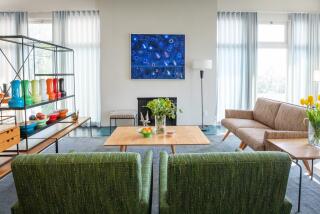Furniture Designed to Grow Up : Home Furnishing: Bauhaus-inspired modular designs are now widely available. They give families with children flexibility to grow.
- Share via
Children may be perpetual delights, but their furniture can create perpetual problems. Once outgrown, those puppy dog-stenciled cribs, quilted plastic changing tables and pint-sized youth beds become eyesores that embarrass children and exasperate adults. Yet families that plan to expand cannot afford to dispose of them.
Even before they are outgrown, nursery essentials tend to be graceless and bulky, robbing cramped quarters and vacation cottages of desperately needed space.
Although part-time parents and grandparents may require baby gear infrequently, they are stuck with it all year long. That’s why people with young children so seldom have room for cars in the garage.
These troubles will soon be obsolete. Today, at last, there are furnishings that mature along with the child.
Flexible, multipurpose furniture modules were introduced in post-World War I Germany by members of the Bauhaus school. Rebelling against the baroque clutter of costly Art Nouveau, these visionaries pioneered simple, functional, durable, space-saving pieces that could be inexpensively mass-produced.
By the end of World War II, its influence had spread to Scandinavia. There, master craftsmen began exporting lightweight birch home and office modules to the United States. Finland’s Muurame Furniture Co. added an innovative line of architect-designed nursery units.
Such systems, in Scandinavian birch, Italian beech and American pine or tubular piping and equipped with safety features, can now be purchased at many local juvenile furniture stores.
Basic modules are small, stackable chests of coordinated heights and widths, coated with mar-resistant clear, bright or pastel enamel. Drawers, doors, tambours and adjustable shelving are interchangeable. Because they are finished on all sides, the modules are expandable in all directions, usable anywhere in the home.
Drop-side cribs double as love seats. Changing tables turn into benches and computer stands. Toy chests and layette wardrobes with removable closet poles are reborn as bookcases and entertainment centers. Adjacent low bureaus become window seats, wall-unit bases or under-bed storage drawers.
Diaper cabinets make great headboards, nightstands, end tables and segments of a buffet or room divider. With the addition of a table top or slide-out shelf, they also serve as desks and vanities.
Twin-sized beds are equally versatile. Removable guard rails turn them into cribs. They can be trundled, double-decked, canopied or elevated into loft beds with integrated modules for storage, work and play. In a childless room, they transform into handsome sofas or join as a dual king bed with modular headboard.
One company adds ageless fantasy panels and facades depicting, for instance, the New York skyline, the Statue of Liberty or a Gothic tower with built-in clock.
There is even recyclable child-safe flooring: colorful interlocking soft-rubber tiles ideal for any room, including the kitchen.
The sleekly sophisticated bed/sitting rooms displayed at these shops reveal no traces of their nursery origins. They are such attractive and functional space-savers that children who grow up with them will surely want to take them along when they leave home.
Infant-to-adult indoor modules are sold by Finlandia Furniture in Santa Monica, Babyland and Fun Furniture in Los Angeles, H.U.D.D.L.E. in West Los Angeles and Santa Ana, and by Bellini, K.I.D.S. Furniture and Kids Room stores throughout Southern California.


